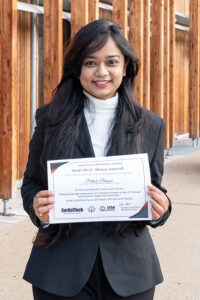Pallabi Bhuyan, Postdoc at Prof Marc Ledendecker’s Professorship of Sustainable Energy Materials, is one of the first people at TUM Campus Straubing (TUMCS) to receive a Humboldt Fellowship. In this interview, Pallabi talks about the fellowship, another award she received in India and her research here in Straubing.

Palladi Bhuyan, Postdoc at the Professorship Sustainable Energy Materials. Photo: Jan Winter/TUM.
Dear Pallabi, you are one of the first people at TUMCS to receive a Humboldt Fellowship. How do you feel?
I am extremely happy to have been awarded with the prestigious Humboldt Fellowship. Looking back, I had planted this dream when I was extremely naive, just enrolled in PhD, back in 2016. It’s a feeling of satiety, I would say. All the struggles and hurdles make sense now with the name of this fellowship being attached to my name. And for this, I would like to offer sincere gratitude to my host Dr. Marc Ledendecker who supported me in each and every aspect that led to the successful attainment of this fellowship. I am extremely motivated to start the proposal and not to mention, looking forward for the outcomes of the proposal.
You also won the best thesis award in corrosion science and engineering across India this year. How hard is it to get such an award?
Yes, I did receive the best thesis award and for this I would like to thank my PhD supervisors who motivated and guided me in the best possible way. To be frank, it is difficult for me to pinpoint the underlying challenges/difficulties in getting this award. However, as much as my knowledge is concerned, the content of the thesis, the outcomes in the form of papers, conferences and the probability of employing such outcomes in industries are gauged by the committee consisting of top scientists and professors who have significantly worked in this field of corrosion science and engineering. Moreover, since it is presented to just one person, and that to annually, so we can consider it as competitive.
„It´s actually the people in the place, which matters me the most“
What did you deal with in your thesis?
In brief, my thesis was majorly focused on tailoring the microstructure to attain a superior corrosion performance in Ni-based superalloy 617, which is commonly used in boiler tubes in coal-fired power plants. Microstructure engineering is considered to be a feasible approach amongst all other known-approaches since the techniques employed can be inserted in the fabrication techniques without doing anything extra that would increase in the cost. The topic of my thesis is “Enhancing the high-temperature hot corrosion (HTHC) resistance in Alloy 617 through microstructural engineering approaches”. Since grain boundaries play a pivotal role in polycrystalline materials, as a first step, I optimized microstructure engineering approaches like grain boundary engineering and serrations to obtain well-engineered microstructures as well as superior corrosion performance in a Ni-based superalloy 617.
Finally, I combined both these successful approaches into a single product microstructure to attain a microstructure consisting of an optimum fraction of low energy boundaries in Alloy 617. This pioneering approach has not only resulted in a much lesser extent of hot corrosion in comparison to its non-engineered counterpart but has also opened up a new dimension that can be exploited to develop resistance against other intergranular-related degradation mechanisms. Apart from the role of grain boundaries, I also investigated the individual effects of other microstructural parameters like grain size, retained strain, and precipitate fraction on HTHC which is important as these insights would serve as valuable inputs while developing damage resistant microstructures for extreme service conditions.
You recently started researching at Prof. Ledendecker’s professorship. What is your research about?
Producing a catalyst with the optimal combination of activity and stability is still a challenge, despite the extensive ongoing research in this field. My research here is to modify the catalyst design in a feasible manner, using my previous knowledge, to attain a synergistic combination of activity and stability, and thereby superior catalytic performance in variety of reactions.
You’ve only been in Straubing for a few months. What do you particularly like about the campus and the city?
Yes, I joined here in May 2023. Its actually the people in the place and not the place, which matters me the most. Fortunately, I am surrounded by intellectual colleagues and supportive friends, and this fact loosened me up and made my shift from India to Straubing an easy pill to swallow as otherwise I thought it would be. Of course, Straubing is small, quiet, and serene, and this fact ticks off most of the points in my list.
